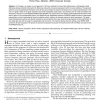40 search results - page 7 / 8 » Fusion of Geometrical and Texture Information for Facial Exp... |
PAMI
2010
13 years 9 days ago
2010
In this paper, we present a novel approach to 3D face matching that shows high effectiveness in distinguishing facial differences between distinct individuals from differences indu...
ICRA
2009
IEEE
14 years 6 days ago
2009
IEEE
— In this paper we present a novel methodology for detection and tracking of facial features like eyes, nose and mouth in image sequences. The proposed methodology is intended to...
CVPR
2007
IEEE
14 years 7 months ago
2007
IEEE
Current approaches to motion category recognition typically focus on either full spatiotemporal volume analysis (holistic approach) or analysis of the content of spatiotemporal in...
ICB
2009
Springer
14 years 4 days ago
2009
Springer
Local Binary Pattern (LBP) histograms have attained much attention in face image analysis. They have been successfully used in face detection, recognition, verification, facial ex...
ICMI
2004
Springer
13 years 11 months ago
2004
Springer
Perhaps the most fundamental application of affective computing would be Human-Computer Interaction (HCI) in which the computer is able to detect and track the user’s affective ...

